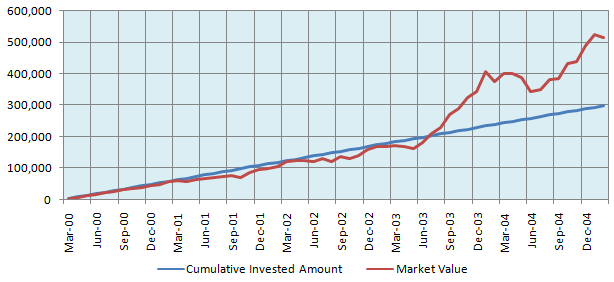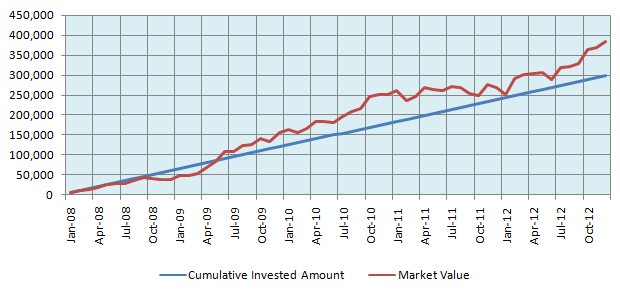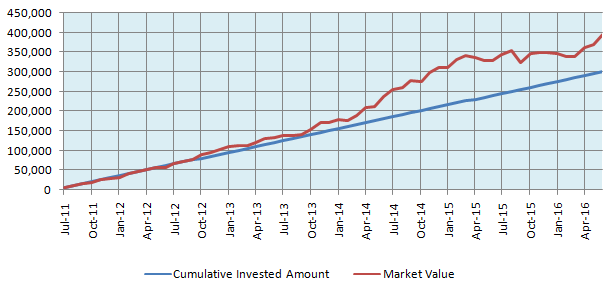How long did Mutual Fund SIPs take to recover from the worst market crashes

I started my investment journey in April or May 1998. I had a lot of interest in the stock market going back to my university days, but the beginning of my investment journey was one of the worst times for the stock market because we were right in the middle of the Asian Currency Crisis then. The market crashed nearly 30% and I saw a large part of my meager savings (I had begun my working career then), which was mostly invested in equity, being wiped out. Out of the comfort of the shelter which parents provide during student years, this was a rude welcome to the real world. Fortunately, there was a wise person who would guide me through the troubled waters of capital markets. He told me that, “you still own the stocks and the mutual funds, even though they might have declined in value temporarily. The value of ownership is often underestimated but the potential is enormous. Be patient.”
The key is to stay invested with your mutual fund systematic investment plans
Virtue of patience
I took his advice and patiently waited for the market to recover. My investments did indeed recover in value and in about 15 – 18 months, I was sitting on a profit of 25 - 30%. Then sometime in March / April 2000, the stock market crashed again in wake of the Ketan Parekh scam; again the market fell more than 30%. The first instinct of most investors would be to sell when market crashes, but I had learnt my lesson from the Asian Currency Crisis; so I remain invested and benefited in the long term. Market corrections are undoubtedly stressful for investors, but they provide the most valuable investment lessons which can be enormously beneficial for us in the long term. One of the earliest investing advices which I received and I shared with you, is the virtue of patience. Over my 20+ years of investment journey, my patience has been tested several times, most severely during the Financial Crisis of 2008 when the market fell by more than 50%. But you need to remain disciplined if you want to create wealth. As Warren Buffet opined, emotional intelligence is more important than IQ in achieving investment success.
Mutual Fund Systematic Investment Plans
Somewhere down the road on my journey beginning in 1998, I learnt about a wonderful investment option called Mutual Fund Systematic Investment Plans (SIP). SIP enables you to take advantage of market volatility to achieve Rupee Cost Averaging. Rupee Cost Averaging helps you reduce your purchase price in volatile markets and enhance it in the long term. Over the last few years, SIP has become extremely popular with retail investors. The SIP book in the Indian mutual fund industry has grown to more than Rs 7,500 Crores a month by June / July this year. September saw record SIP inflows despite the market being highly volatile during that month.
The growing SIP book in the face of volatility demonstrates the maturity of the Indian investors. However, based on my interactions with investors, I think there may be some misconceptions about SIP among a section of investors, which we should address. One of the main misconceptions about SIP is that, SIP can never give negative returns. This is a misconception. Whether you are investing in lump sum or through SIP, you are investing in the same universe of underlying assets. If you are expecting protection from volatility through SIP, then you are sadly mistaken. Many mutual fund SIPs have given negative returns in the last one year. Negative short term SIP returns is not a new phenomenon; we saw this in 2008 also, just that SIPs were not as popular back then, as it is now. You should know that SIP helps you take advantage of volatility in the long term, but it will not protect you from short term losses.
Did you know what are the 10 things you should do in volatile markets
How long do SIPs take to recover from market crashes?
While there are many blogs in the digital media, including us, which espouse the benefits of continuing your SIPs in market corrections, there is no denying that deep market corrections or bear markets are stressful for investors. When you continue your SIP in bear markets or deep corrections, with every installment your losses can become bigger. While many Advisorkhoj regular readers understand that these losses are only notional or paper losses, but in deep corrections / bear markets investors would like to know, for how long losses will continue? When their SIPs recover in value? Each bear market is different in terms of the quantum of correction and length of correction. In an attempt to find an answer to this question, we have analyzed the three worst bear markets in the last 20 years.
Ketan Parekh scam, dotcom crash followed by 9/11 (2000 - 2001):
This was possibly the longest bear market. The market crashed in March 2000 in the wake of Ketan Parekh scam. There were intermittent recoveries but the market saw corrections due to subsequent crises. The market fell by nearly 40% from the previous all time high. The market bottomed out by the beginning of 2002, but full recovery took much longer. Only by the beginning of 2004, Nifty recovered to its March 2000 levels.Financial Crisis of 2008:
This was the worst financial crisis the world faced after the Great Depression of the 1930s. The Indian stock market crashed by more than 50%. Unlike previous global financial crises, the financial crisis of 2008 was felt around the world, because global economies were integrated than ever before. However, Governments and central banks around the world including our Government and RBI reacted much faster. Therefore, the short term recovery from the 2008 Financial Crisis was faster than the dotcom crash. But the after effects of the 2008 financial crisis lingered much longer. In fact, they are being even felt today, 10 years later.US Sovereign Debt rating downgrade and Fed QE taper tantrum (2011 to 2013):
In 2011, the credit rating agencies downgraded US sovereign debt rating. This caused panic in the market with fears of another global recession and caused stocks to tumble around the world. In 2011, the Nifty crashed more than 20% but recovered in 2012. Again in the middle 2013, the US Federal reserve announced a tapering of their Government Bond purchase program. The nickname for market’s reaction to US Fed’s QE tapering was Taper Tantrum. The stock market became volatile and recovered only by the end of 2013, mainly in anticipation of NDA win in the upcoming 2014 Lok Sabha election.
For purposes of our analysis, let us assume you started monthly SIPs of Rs 5,000 p.m. at the market top and as soon as you started your SIP, the market crashed – this is usually the worst case scenario for investors. We will see how long it took for your SIP to recover its losses and the investment value 5 years later (from the time of SIP initiation). For this analysis, let us assume you invested in Nifty-50 (total returns index).
Investing during Ketan Parekh/ dotcom / 9-11 crisis
The chart below shows the returns of Rs 5,000 monthly SIP in Nifty-50 TRI from March 2000 to March 2005.

Source: Advisorkhoj Benchmark SIP returns
You can see that it took more than three year for your profits to turn positive. We mentioned earlier that this was the most prolonged bear market in the last 20 years. But once the market consolidated, it simply raced away making new highs along the way. With a cumulative investment of Rs 300,000 through monthly SIP during this phase (March 2000 to March 2005) you could have accumulated a corpus of Rs 523,200. The SIP returns (XIRR) during this period was more than 22%.
Investing during 2008 financial crisis
The chart below shows the returns of Rs 5,000 monthly SIP in Nifty-50 TRI from January 2008 to January 2013. As mentioned earlier, 2008 was the worst financial crisis in 8 decades. The price damage done to stocks during this period was enormous. Let us see how our SIP fared in this 5 year period.

Source: Advisorkhoj Benchmark SIP returns
The price damage was so severe in Financial Crisis of 2008, that it took Nifty-50 TRI almost 6 years to go back to January 2008 levels. However, in the chart above, you can see that in less than 18 months, your profits turned positive despite the severe price correction. This demonstrates the benefit of Rupee Cost Averaging through SIP in deep market corrections or bear markets. With a cumulative investment of Rs 300,000 through monthly SIP during this phase (January 2008 to January 2013) you could have accumulated a corpus of Rs 395,000. The SIP returns (XIRR) during this period was more than 10%, significantly higher on a post tax basis than bank FD, which many investors thought was a better investment during the worst financial crisis of our times.
Investing through US sovereign rating downgrade through taper tantrum (2011 to 2013)
The chart below shows the returns of Rs 5,000 monthly SIP in Nifty-50 TRI from July 2011 to July 2016. We saw three deep corrections during this phase 2011 (US sovereign rating downgrade), mid 2013 (Fed taper tantrum) and 2015-16 (China economic slowdown, Brexit and crude price correction), each of which would have tested the investor’s patience. Let us see how our SIP performed during this phase, if your remained patient.

Source: Advisorkhoj Benchmark SIP returns
You can see that it took less than 12 months for your SIP profits to turn positive. Despite several other corrections in the interim, with a cumulative investment of Rs 300,000 through monthly SIP during this phase (January 2008 to March 2013) you could have accumulated a corpus of Rs 402,740. The SIP returns (XIRR) during this period was around 12%.
Summary of the three SIP scenarios

Note that in all the three scenarios our asset is the Nifty50 TRI. Mutual fund schemes are mandated to beat the market benchmark and therefore, top performing mutual fund schemes are likely to beat the market benchmark. Did you know what is the importance of market benchmarks in India
To analyze SIP performance of any Benchmark, do check Benchmark SIP Returns
Conclusion
In this blog post, we have discussed the performance of SIPs in the worst bear markets of the last 20 years. We have seen that SIPs can give negative returns in the short term. It can take 12 to 18 months, sometimes even longer (like in the 2000 to 2002 market), for SIPs to recover from bear market corrections, but over a sufficiently long investment horizon (at least 5 years), SIPs can give good returns even if the correction is very deep. SIPs should always be made with a long investment horizon and you should not let short term volatility bother you; in any case, the short term pain will not last very long. Equity is the best performing asset class in the long term and mutual fund SIP is the one of the best ways of investing in equities for wealth creation.
Did you know which are the best dates to do mutual fund SIPs
Mutual Fund Investments are subject to market risk, read all scheme related documents carefully.
RECOMMENDED READS
LATEST ARTICLES
- Why you need to have hybrid mutual funds in your portfolio: Different types of funds Part 2
- Why you need to have hybrid mutual funds in your portfolio: Misconceptions Part 1
- Which is the best time to invest in mutual funds
- Economic slowdown: Is it real and what should you do
- Importance of liquidity in investing: Mutual funds are ideal solutions
An Investor Education Initiative by ICICI Prudential Mutual Fund to help you make informed investment decisions.
Quick Links
Follow ICICI Pru MF
More About ICICI Pru MF
POST A QUERY




